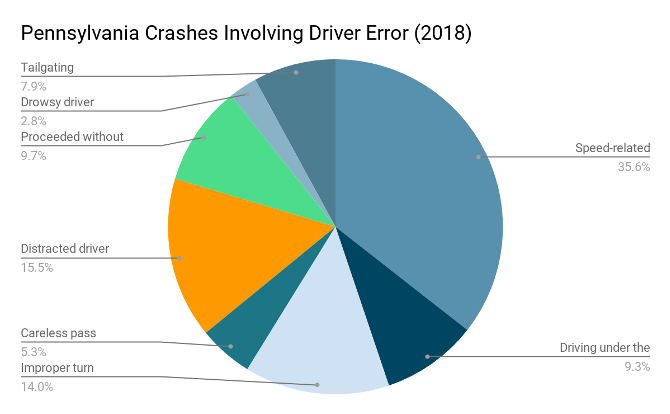
Your guide to laws concerning the use of cellphones and other distractions while operating a vehicle
Hopefully, you agree that you should never drink a beer while driving your car.
So why would you send a text?
According to a study by Car and Driver magazine, sober drivers who were texting or reading an email took significantly longer to react to road hazard than drivers who were legally intoxicated.
| Driver reaction time (based on condition/behavior) | |
|---|---|
| Condition/behavior | Braking time |
| Sober | 0.54 seconds |
| Intoxicated | Add 4 feet |
| Reading an email | Add 36 feet |
| Sending a text | Add 70 feet |
Given this data, it’s perhaps unsurprising that 9 people are killed and more than 1,000 are injured every day in the United States in crashes involving distracted drivers.
Pennsylvania has taken steps to reduce distracted driving accidents, including passing laws prohibiting the use of certain electronic devices when a car is in motion.
Let’s take a closer look at distracted driving laws in Pennsylvania, including how they might impact your personal injury claim.
Pennsylvania distracted driving statistics
According to the Pennsylvania Department of Transportation, distracted driving was a factor in 14,292 crashes in 2018. Of those crashes, 63 were fatal.
Tweet this

Source: “Crash Facts & Statistics,” Pennsylvania Department of Transportation
Unfortunately, research shows that drivers in Pennsylvania and nationwide still don’t take distracted driving seriously enough.
In an effort to make clear just how serious distracted driving is, Enjuris has compiled some alarming facts:
- 2,841 people were killed in distracted driving accidents across the country in 2018 (more than the number of people killed in drunk driving accidents)
- Cell phone users are 5 times more likely to get into an accident than undistracted drivers
- Text messaging increases the risk of a crash by 23 times
- Sending or reading a text message takes your eyes off the road for 5 seconds, long enough to cover the distance of a football field when driving at 55 miles per hour
Common types of distractions
Though cell phone use and text and driving tend to be most commonly associated with the term “distracted driving,” technically a distraction can be any activity that diverts your attention from driving. Traffic safety experts classify distractions into 3 main types:
- Manual distractions are when you move your hands away from the wheel
- Visual distractions are when you focus your eyes away from the road
- Cognitive distractions are when your mind wanders away from the task of driving
One reason texting is so dangerous is that it involves all 3 types of distractions.
Other common distractions include:
- Talking to passengers
- Eating and drinking
- Shaving
- Fiddling with the radio
- Using the GPS
- Putting on makeup
- Smoking
- Filing or clipping fingernails
- Reaching for the glove compartment
- Breaking up fights between children
- Putting in contact lenses
- Picking something up from the floor or between the seats
Distracted driving laws in Pennsylvania
There are lots of potential distractions for drivers, but only some of them are illegal.
Title 75 of the Pennsylvania Vehicle Code prohibits any driver in Pennsylvania from using “an interactive wireless communication device to send, read, or write a text-based communication while the car is in motion.”
An “interactive wireless communication device” includes a wireless phone, personal digital assistant, smartphone, portable or mobile computer, and any similar device that can be used for texting, instant messaging, emailing, or browsing the internet.
In addition, drivers in Pennsylvania are prohibited from wearing headphones and earphones.
If caught, the penalty for using an interactive wireless communication device while driving is a $50 fine, plus court costs and other fees.
The violation carries no points as a penalty and won’t be recorded on your driving record if you’re a non-commercial driver. It will be recorded on commercial drivers’ records as a non-sanction violation.
What’s more, Daniel’s Law enhances the penalties if a driver causes injuries or death to another person while texting behind the wheel. In these cases, the driver can face:
- A 2-year jail sentence for causing serious bodily injury while texting, or
- A 5-year jail sentence for causing a fatality while texting.
Distracted driving laws vary by state, so if you drive into a neighboring state that has different laws, you’ll need to comply with those laws.
Keeping up to date with ever-changing distracted driving laws isn’t easy, but claiming ignorance won’t get you out of a citation. Your safest option is to simply refrain from using all technological devices while driving.
How distracted driving affects liability in a car accident
In Pennsylvania, the fine for using a cell phone or other electronic communication device while driving is relatively small. The real cost of using such a device shows up when the person using the device causes a car accident.
Typically, when one driver sues another driver for damages caused by a car accident, the driver bringing the lawsuit (the “plaintiff”) must prove that the driver being sued (the “defendant”) was negligent.
In Pennsylvania, “negligence” is defined as the failure to use reasonable care to prevent harm to yourself or someone else. If the plaintiff can prove that the defendant was using an electronic communication device (or was otherwise distracted) when the accident occurred, the plaintiff can generally establish negligence.
What’s more, if the defendant received a citation for violating the distracted driving statute, the defendant will be presumed negligent and the defendant will have the burden of proving that they didn’t cause the accident. This is referred to as “negligence per se.”
To put it simply, if a Pennsylvania car accident is caused by a distracted driver, the driver will likely be found negligent and the other driver will be able to recover damages for their injuries.
How to prove distracted driving
Unfortunately, if the defendant didn’t receive a citation, proving distracted driving can be quite challenging.
Reviewing phone records can help, but they aren’t helpful if the distraction was caused by something else like reaching between the seats to find a piece of candy.
This is where a Pennsylvania car accident attorney can help. An experienced attorney can help gather evidence to support your claim that the defendant was distracted, including deposition testimony from the driver and any witnesses.
Begin your search by checking out our list of experienced Pennsylvania personal injury lawyers to find a law firm near you.
See our guide Choosing a personal injury attorney.
